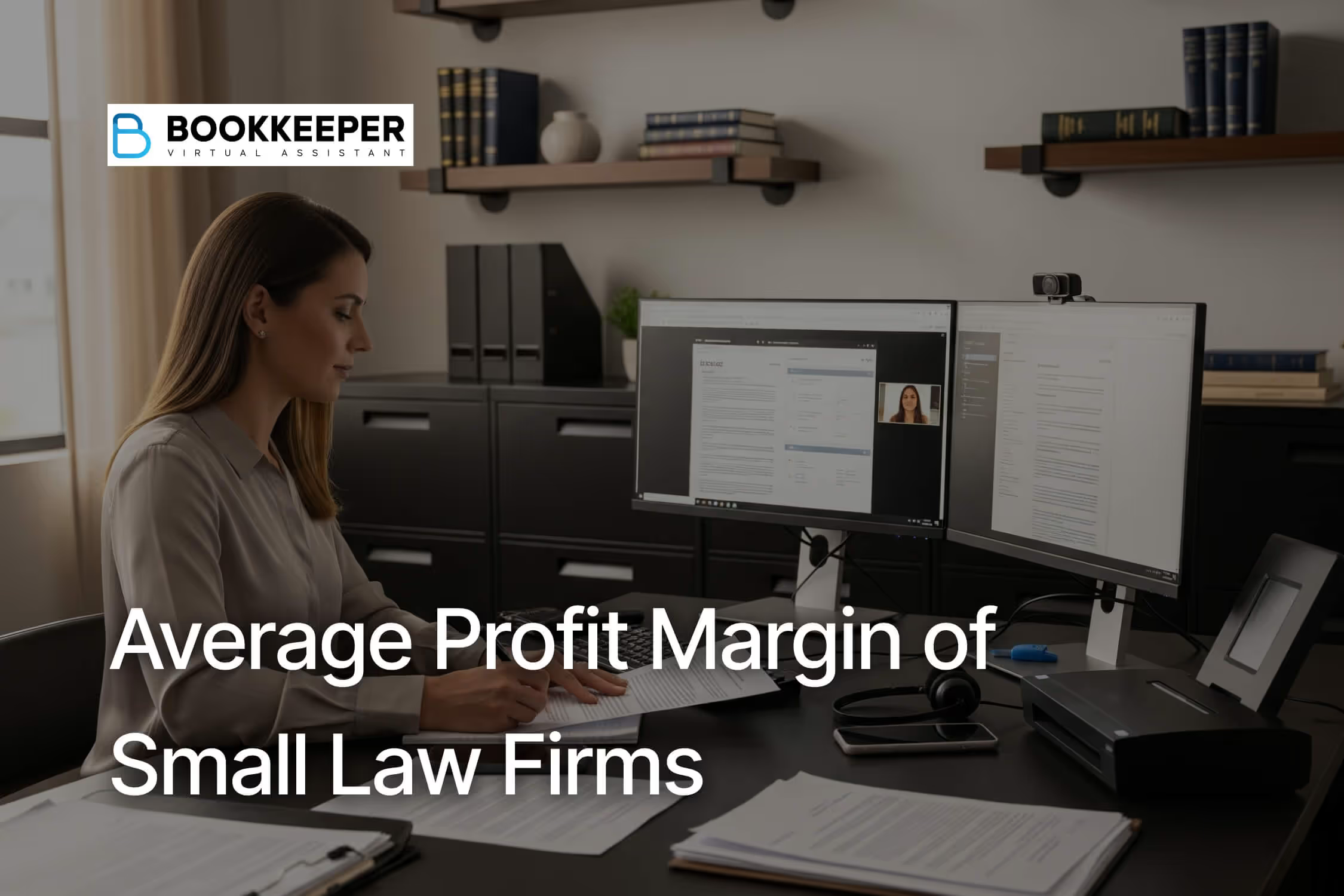Running a small law firm is no small feat. It’s a challenging business due to competition and the dual roles you juggle as a lawyer and a business owner. While you may have extensive legal expertise, it’s natural to have questions about your firm’s overall financial health.
Understanding how much profit your firm is generating is critical to keeping your operations running. If you’ve ever wondered whether your firm’s margins measure up to industry standards, you’re not alone. In this guide, we’ll break down what profit margin means, highlight reliable industry benchmarks, and share practical tips to help you improve your law firm’s profitability.
What is the Average Profit Margin for Small Law Firms?
Let’s dive right in. When browsing articles online, you may come across claims that the American Bar Association (ABA) sets the median profit margin for small law firms. However, this data is not supported by the ABA and appears to originate from third-party businesses rather than official sources.
In reality, there is no single, universally accepted “average” or industry benchmark. The only proven long-term data comes from a three-decade study (1986–2021) conducted by The American Lawyer Survey, which found that law firm profit margins generally range between 35% and 45%.
These figures represent the median point, meaning half of all firms fall above or below this range. Factors such as geographic location, labor costs, and fee structures will influence where your firm lands within these benchmarks.
A healthy profit margin for a small law firm typically falls between 30% and 35%. But don’t panic if your firm is currently below that range—there’s room for growth, and we’ll cover strategies to help you improve.
Defining Law firm Profit Margin
A law firm profit margin is the percentage of revenue remaining after deducting all operating expenses. The basic formula is:
Profit Margin = (Net Income ÷ Total Revenue) × 100
Where:
- Net Income = Total Revenue - Total Operating Expenses
- Total Revenue = All money coming into your firm (fees, retainers, etc.)
- Total Operating Expenses = All costs (salaries, rent, software, marketing, etc.)

For example, if your firm generated $400,000 in revenue and had $250,000 in operating expenses, your net income would be $150,000. Using the formula, your profit margin is 37.5% ($150,000 ÷ $400,000 × 100).
This percentage tells you how efficiently your firm converts revenue into profit. The higher the percentage, the more money you're keeping from every dollar earned.
How Do Small Law Firms Make Money?
Most small law firms generate revenue primarily through legal services billed to clients. This can take several forms:
- Billable Hours: The most common model, where clients are charged for the time you spend working on their legal matters.
- Flat Fees: A fixed price for specific services, giving clients cost certainty and potentially boosting profitability if projects are scoped correctly.
- Contingency Fees: Common in personal injury and certain litigation cases, where you only get paid if the client wins—typically as a percentage of the settlement or award.
- Retainers: Upfront payments that provide steady cash flow and reduce collection issues. These are especially effective when paired with trust account management.
- Referral Fees: Compensation for referring cases to other attorneys, though this depends on jurisdictional rules and ethical guidelines.
Understanding these revenue streams is crucial because the way you structure fees directly affects your profitability.
How Profitable are Small Law Firms?
Small law firms with well-managed expenses can be highly profitable. While larger firms benefit from economies of scale, smaller firms often gain an advantage through lower overhead costs and efficient management of billable hours.
That said, many solo practitioners experience lower profit margins compared to small partnerships. According to the Legal Trends Report, solo attorneys spend an average of only 2.9 hours per workday on billable tasks, with the rest of their time consumed by non-billable work such as administration.
This imbalance directly impacts profitability—every hour spent on administrative tasks is an hour not spent generating revenue.
Does Practice Area Matter in Profit?
Yes. Your practice area directly influences both profit margins and revenue. Some areas naturally command higher fees or have lower associated costs, while others may involve more client management or longer case durations.
For example, practice areas like intellectual property and corporate law tend to generate higher margins due to their technical nature, the specialized expertise required, and the high value clients place on these services. On the other hand, volume-based practices rely on handling a larger caseload at lower margins. To put this in perspective, state courts in the United States handle approximately 66 million cases each year, with family law matters accounting for about 6% of them.
Neither model is inherently better. High-margin practices require specialized expertise and often longer client relationships, while volume-based practices can provide predictable income when supported by efficient systems.
Factors Influencing Profit Margins
With the profit margin formula we showed earlier, operating expenses are a surface level factor. But diving deep into it, you'll see that there are more elements contributing to profit margin. It composes a delicate balance where adjustments in one area can ripple through the others:
- Labor Costs: Typically the largest overhead expense, including salaries, benefits, and all employee-related costs.
- Geographic Location: A small family law firm in a rural area may achieve higher profit margins than one in a metropolitan area due to lower overhead.
- Billable Rate: The proportion of an attorney’s or paralegal’s total working hours that are actually billed to clients.
- Collection Rates: Low collection rates are a huge drain on profit margins, especially when overdue invoices or inefficient billing processes reduce the amount of revenue you actually collect.
- Technology Investment: Firms that fail to adopt legal tech often see lower profit margins because they miss out on the automation and streamlined operations that technology provides.
- Client Mix: Serving higher-value clients who can afford premium services directly impacts the bottom line.
- Client Retention: According to Harvard Business Review, acquiring a new client can cost 5–25 times more than retaining an existing one—making client loyalty one of the most cost-effective drivers of profitability.
How to Improve Law Firm Profitability

Here are strategies that work for small firms on boosting their margins:
Optimize Your Expenses
Regularly review operating costs and identify areas where you can reduce spending without sacrificing service quality. Even small savings across multiple categories can add up and impact your bottom line.
Adjust Your Rates
Ensure your billing rates reflect your expertise, market value, and overheads. Don’t hesitate to adjust them if needed. Underpricing leaves money on the table, while overpricing can deter clients—finding the right balance is key.
Delegate Non-Billable Work
One of the biggest drains on profitability is having attorneys handle tasks like bookkeeping or financial management. Having professional accounting support can improve collections, reconciliations, and trust accounting.
Focus on Niche
Instead of being a generalist, consider specializing in a particular area to serve a specific client demographic. Niche expertise allows you to command higher fees and attract clients willing to pay for your specialized services.
Embrace Technology
Invest in practice management software, automated billing, and other legal tech tools that reduce manual work, and allow you to deliver services more efficiently.
Monitor Key Metrics
Regularly track KPIs that impact profitability, such as billable hours and realization rates. You can’t improve what you don’t measure. Monitoring performance provides actionable insights into what’s working, and what’s not.
Is Your Firm Profit Margin Set Right?
The key is finding the right balance for your specific situation. A healthy profit margin supports reinvestment, growth, and long-term security—but it should also align with your goals for your practice and life. Start by calculating your current margin—if it’s consistently below the industry average, that’s a signal to identify areas for improvement. Even small adjustments can deliver big results over time.
At Bookkeeper.law, we help attorneys and small firms improve profitability by optimizing the factors that matter most. Our bookkeepers provide expert support at a lower cost while maintaining the quality you expect from top professionals, helping you save more and keep more of your earnings.

.jpg)



